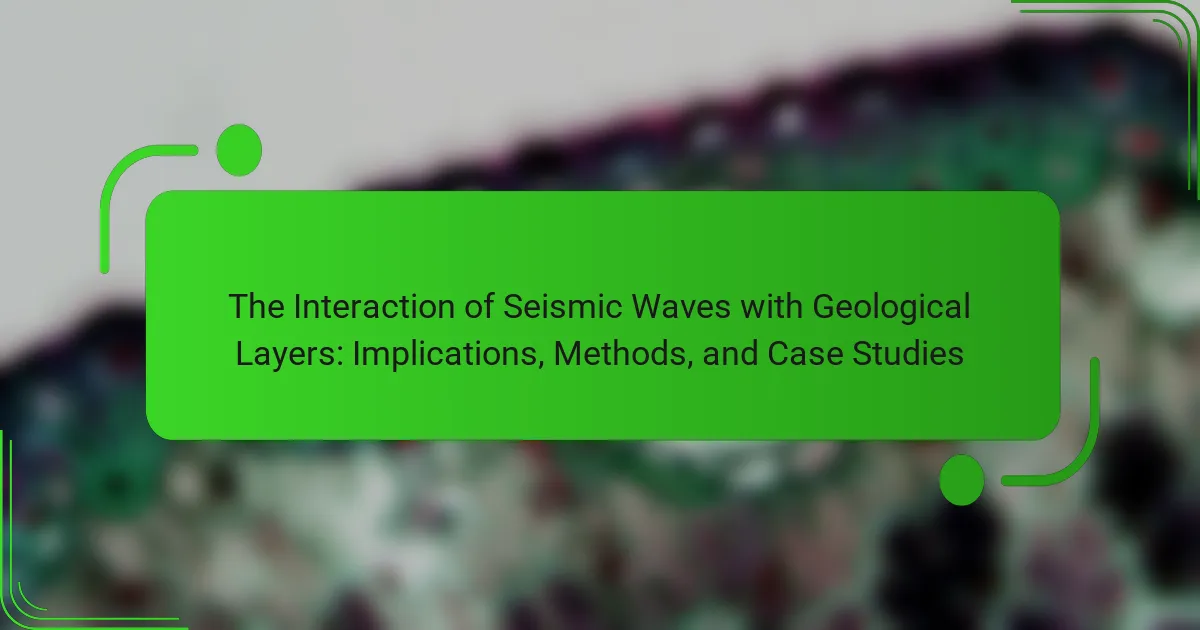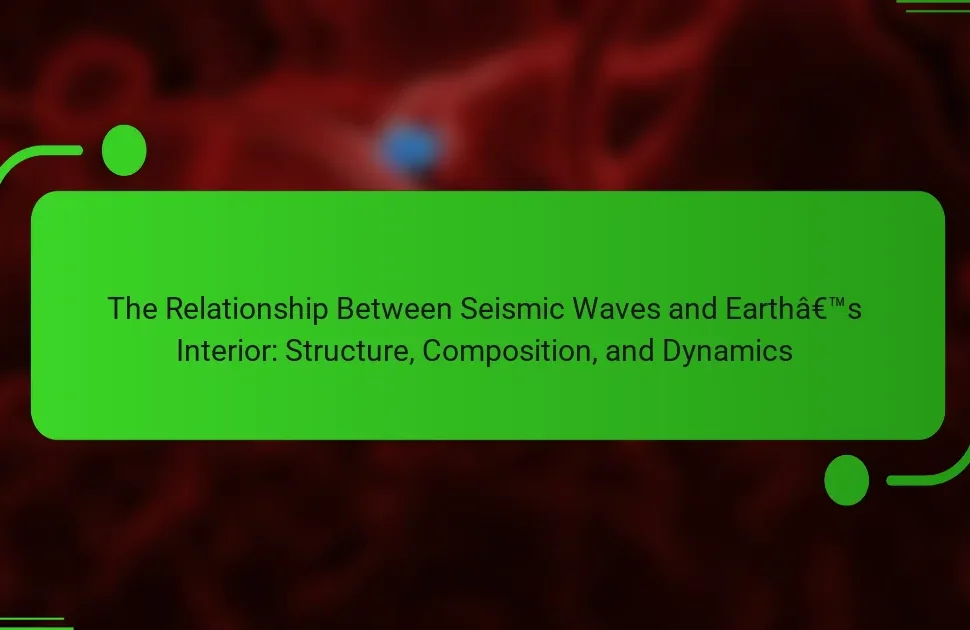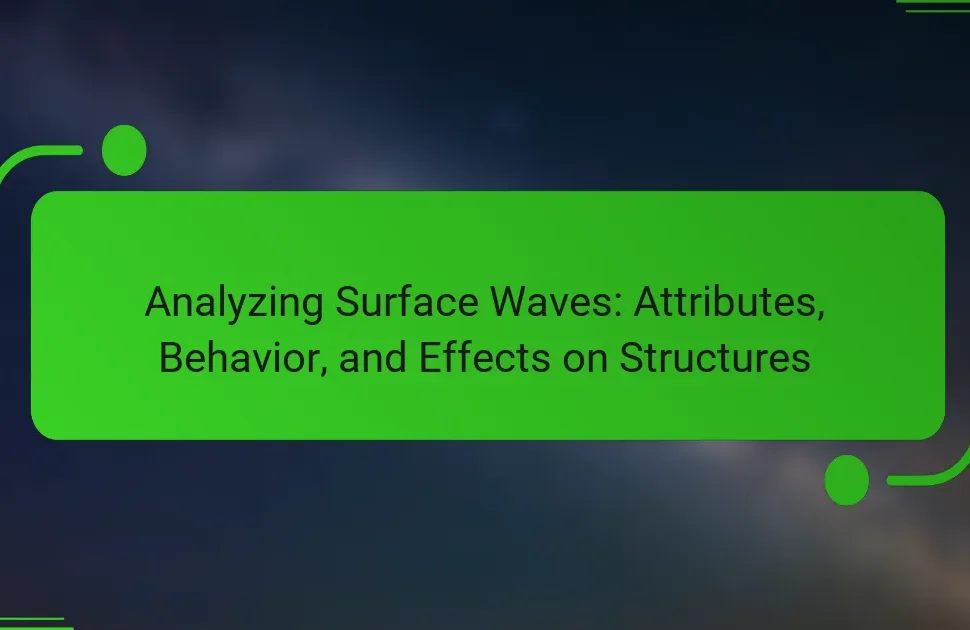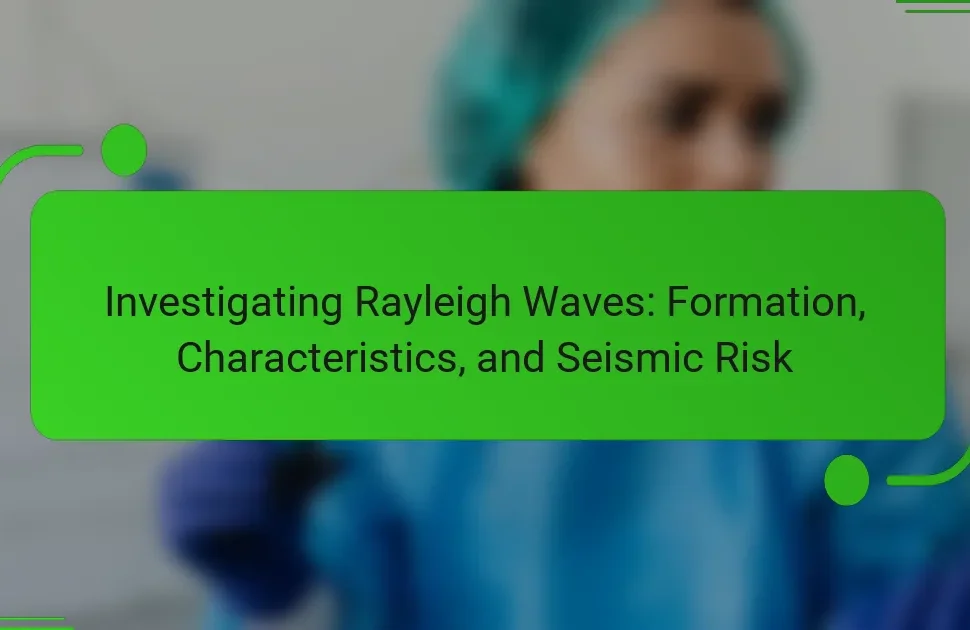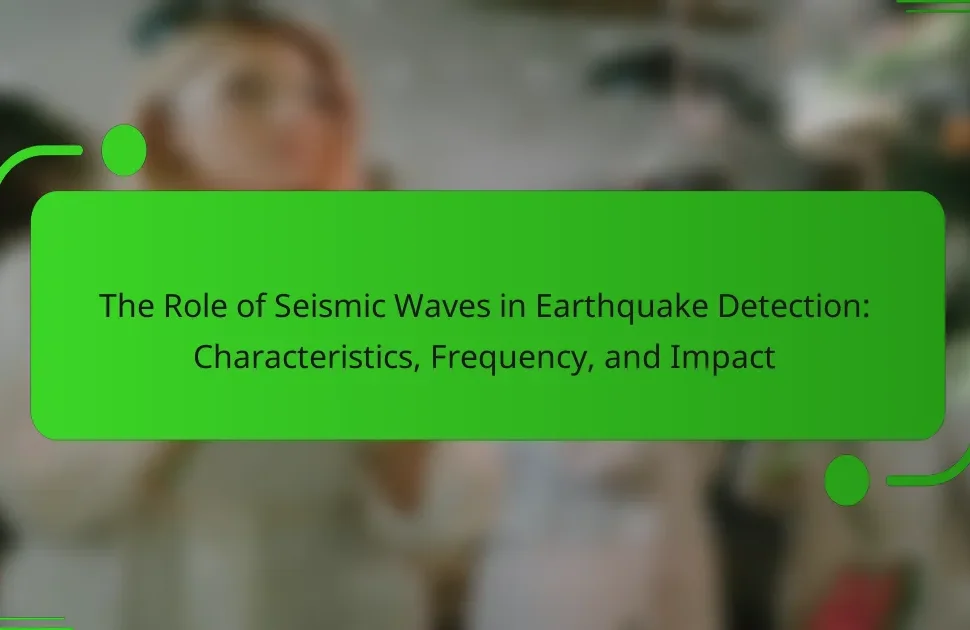Seismic waves are energy waves that travel through the Earth’s geological layers, generated by events such as earthquakes or artificial explosions. They are categorized into body waves, which include primary waves (P-waves) that compress and expand materials, and secondary waves (S-waves) that cause up-and-down or side-to-side ground movement. Understanding the interaction of seismic waves with geological layers is crucial for geologists, as it reveals insights into the Earth’s interior structure, including the presence of faults and natural resources. Various methods, including laboratory experiments, field measurements, and numerical simulations, are employed to study these interactions. Notable case studies, such as the Northridge, Tōhoku, and Haiti earthquakes, highlight the significant impact of geological conditions on seismic wave behavior and their implications for engineering and disaster preparedness.
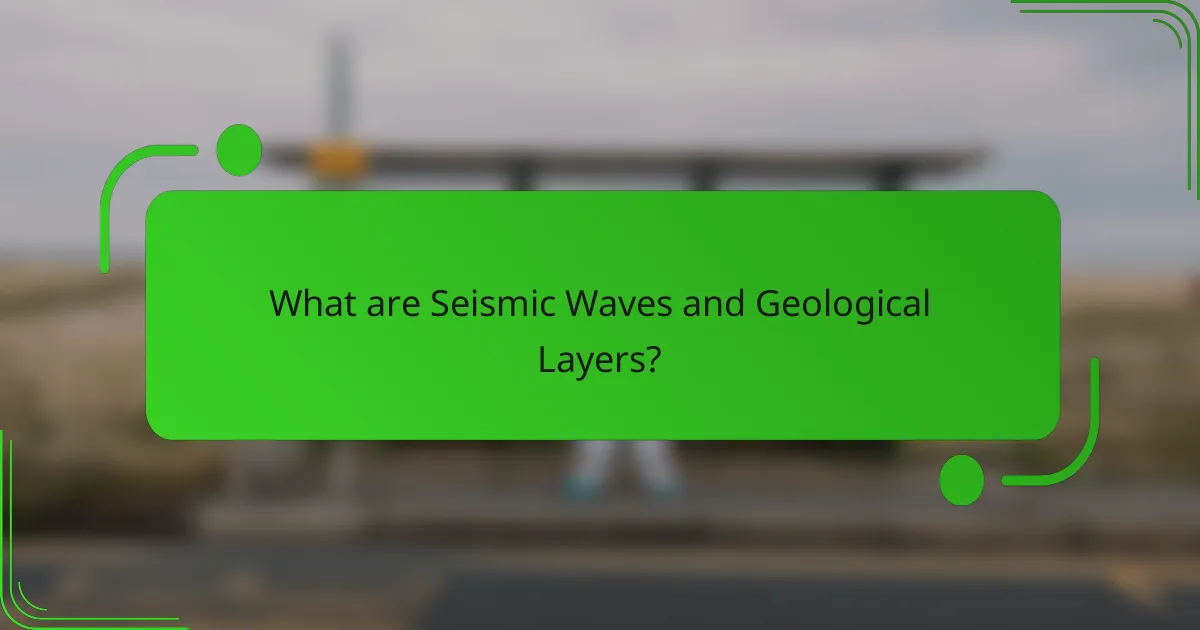
What are Seismic Waves and Geological Layers?
Seismic waves are energy waves that travel through the Earth’s layers. They are generated by geological events like earthquakes or artificial sources such as explosions. Seismic waves are classified into two main types: body waves and surface waves. Body waves include primary waves (P-waves) and secondary waves (S-waves). P-waves compress and expand the material they move through. S-waves move the ground up and down or side to side.
Geological layers refer to the various strata of rock and sediment that make up the Earth’s crust. These layers vary in composition, density, and thickness. The study of seismic waves helps geologists understand the properties of these geological layers. Seismic waves change speed and direction when they encounter different materials. This behavior provides insights into the structure and characteristics of the Earth’s interior. For example, seismic data can reveal the presence of faults, oil reservoirs, and other geological features.
How do seismic waves propagate through geological layers?
Seismic waves propagate through geological layers by traveling as mechanical waves through the Earth’s crust. These waves can be classified into two main types: primary (P) waves and secondary (S) waves. P waves are compressional waves that move faster and can travel through solid and liquid layers. S waves are shear waves that move slower and can only travel through solid materials.
As seismic waves encounter different geological layers, their speed and direction change due to variations in density and elasticity. This phenomenon is known as refraction. When waves pass from one material to another, they may also reflect back to the surface. The interaction of seismic waves with geological layers provides critical information about subsurface structures.
For example, studies have shown that analyzing the arrival times of seismic waves allows geologists to infer the composition and properties of the Earth’s interior. This method is widely used in fields such as oil exploration and earthquake research.
What types of seismic waves exist and how do they differ?
There are two primary types of seismic waves: body waves and surface waves. Body waves travel through the Earth’s interior, while surface waves move along the Earth’s surface.
Body waves are further divided into two types: P-waves (primary waves) and S-waves (secondary waves). P-waves are compressional waves that can travel through solids, liquids, and gases. They are the fastest seismic waves and arrive first during an earthquake.
S-waves are shear waves that can only travel through solids. They are slower than P-waves and arrive after them during seismic events.
Surface waves include Love waves and Rayleigh waves. Love waves move horizontally and cause significant ground shaking. Rayleigh waves roll along the ground, causing both vertical and horizontal movement.
In summary, P-waves and S-waves are body waves, while Love waves and Rayleigh waves are surface waves. Each type differs in its movement and the materials it can traverse.
What are the main geological layers that interact with seismic waves?
The main geological layers that interact with seismic waves are the crust, mantle, and core. The Earth’s crust is the outermost layer, composed of solid rock. It interacts with seismic waves primarily through the propagation of surface waves. The mantle lies beneath the crust and is composed of semi-solid rock. It interacts with seismic waves through the transmission of both P-waves and S-waves. The core, consisting of a liquid outer core and a solid inner core, interacts with seismic waves by reflecting and refracting them. This interaction is crucial for understanding the Earth’s internal structure. Seismic waves travel at different speeds through these layers, which provides insights into their composition and state.
Why is understanding the interaction of seismic waves with geological layers important?
Understanding the interaction of seismic waves with geological layers is crucial for accurate subsurface imaging. This knowledge aids in identifying the composition and structure of the Earth’s crust. Seismic waves change speed and direction when they encounter different materials. This change provides essential data for geological mapping and resource exploration. For instance, oil and gas companies rely on seismic data to locate reserves. Additionally, understanding these interactions helps assess earthquake risks. By analyzing seismic wave behavior, scientists can better predict seismic hazards. This predictive capability is vital for urban planning and infrastructure development.
What implications does this interaction have for earthquake prediction?
The interaction of seismic waves with geological layers has significant implications for earthquake prediction. This interaction can provide insights into the subsurface structure and properties of the Earth. By analyzing how seismic waves change speed and direction when they encounter different geological layers, scientists can identify potential fault lines and areas of stress accumulation.
For example, studies have shown that regions with complex geological structures often correlate with higher seismic activity. The ability to model these interactions improves the accuracy of seismic hazard assessments. Furthermore, advancements in technology, such as machine learning algorithms, enhance the predictive capabilities by analyzing vast amounts of seismic data.
Research has demonstrated that understanding the behavior of seismic waves can lead to better early warning systems. These systems can potentially provide seconds to minutes of advance notice before an earthquake strikes, allowing for emergency measures to be implemented.
How does this knowledge affect construction and engineering practices?
Understanding the interaction of seismic waves with geological layers significantly impacts construction and engineering practices. This knowledge allows engineers to assess ground stability and seismic risks more accurately. It informs the design of structures to withstand seismic forces. For example, buildings in earthquake-prone areas can be designed with enhanced materials and flexible foundations.
Research shows that site-specific seismic analysis can reduce damage during earthquakes. The National Earthquake Hazards Reduction Program emphasizes the importance of this analysis in engineering standards. Additionally, knowledge of geological layers aids in choosing appropriate construction methods and materials. This ensures that projects are not only safe but also cost-effective. Overall, integrating seismic wave interaction knowledge leads to safer, more resilient infrastructure.
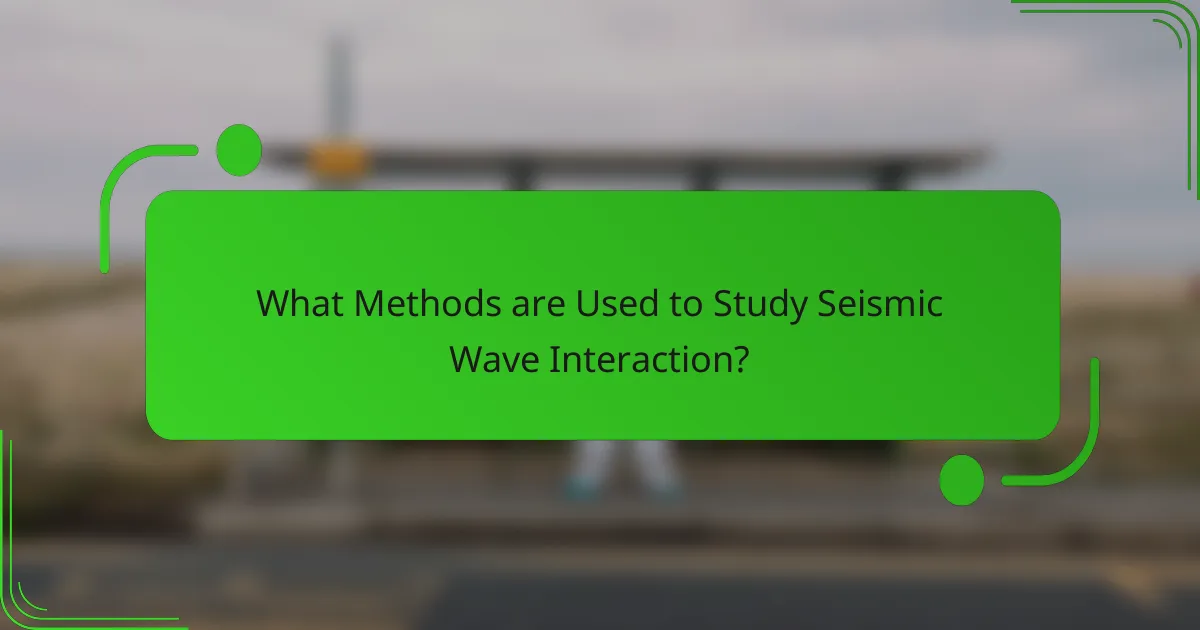
What Methods are Used to Study Seismic Wave Interaction?
Seismic wave interaction is studied using various methods including laboratory experiments, field measurements, and numerical simulations. Laboratory experiments involve creating controlled environments to observe wave behavior in different materials. Field measurements utilize seismic sensors to capture real-time data from earthquakes or artificial sources. Numerical simulations apply mathematical models to predict wave behavior in complex geological settings. These methods collectively enhance understanding of how seismic waves interact with geological layers. Research shows that combining these approaches leads to more accurate models and predictions.
How do researchers measure seismic wave behavior in geological layers?
Researchers measure seismic wave behavior in geological layers using various techniques. They primarily employ seismic surveys, which involve generating seismic waves and recording their travel through the Earth. This is typically done using controlled sources like explosives or vibrating machines.
The recorded seismic waves are analyzed to determine their velocity and amplitude. These parameters provide insights into the properties of geological layers. Researchers utilize tools such as seismographs and geophones to capture wave data accurately.
Data interpretation often involves techniques such as reflection and refraction seismology. These methods help in mapping subsurface structures and identifying material types. The analysis of seismic wave behavior is crucial for applications like oil exploration and earthquake studies.
What tools and technologies are commonly used in seismic studies?
Seismic studies commonly utilize tools such as seismometers and accelerometers. Seismometers measure ground motion caused by seismic waves. Accelerometers capture rapid changes in velocity during seismic events. Geophones are also used to detect and convert ground motion into electrical signals.
In addition, Global Positioning System (GPS) technology aids in monitoring ground displacement. Software for seismic data processing, such as SeisComP and ObsPy, helps analyze the collected data. Additionally, synthetic aperture radar (SAR) is employed to detect ground deformation.
These tools are essential for understanding seismic wave behavior and geological interactions. Their use enhances the accuracy of seismic studies and contributes to disaster preparedness.
What are the key methodologies for analyzing seismic data?
Key methodologies for analyzing seismic data include reflection seismology, refraction seismology, and seismic tomography. Reflection seismology uses seismic waves that reflect off geological layers to create images of subsurface structures. This method is widely used in oil and gas exploration. Refraction seismology involves measuring the travel times of seismic waves that refract through different geological materials. It helps in determining layer velocities and depths. Seismic tomography employs algorithms to construct 3D models of subsurface structures by analyzing seismic wave travel times from multiple sources. These methodologies are essential for understanding subsurface geology and resource exploration.
What challenges do scientists face in studying seismic waves?
Scientists face several challenges in studying seismic waves. One major challenge is the complexity of geological structures. Variations in rock types and densities affect wave propagation. Another challenge is the need for precise instrumentation. Accurate measurements are crucial for understanding seismic activity. Additionally, interpreting seismic data can be difficult. The signals can be noisy and require advanced processing techniques. Limited access to certain regions also poses a problem. Remote or hazardous locations can hinder data collection. Lastly, predicting seismic events remains a significant challenge. Current models often cannot accurately forecast earthquakes. These challenges complicate the study of seismic waves and their implications.
How do variations in geological layers complicate seismic analysis?
Variations in geological layers complicate seismic analysis by affecting wave propagation. Different materials have distinct densities and elastic properties. These differences can cause seismic waves to refract, reflect, or attenuate unpredictably. For instance, a layer of soft sediment over hard rock can significantly alter wave speed and direction. This complexity makes it challenging to interpret seismic data accurately. Additionally, variations can lead to multiple wave arrivals, complicating the identification of primary seismic events. Consequently, accurate subsurface mapping becomes difficult, impacting resource exploration and hazard assessment.
What are the limitations of current seismic wave study methods?
Current seismic wave study methods have several limitations. One major limitation is the difficulty in accurately interpreting complex geological structures. Seismic waves can be distorted by varying material properties, leading to misinterpretations. Additionally, the resolution of seismic imaging can be inadequate for detailed subsurface analysis. This often results in incomplete data about geological formations.
Another limitation is the reliance on surface measurements, which may not capture deeper geological features. This can hinder the understanding of seismic wave behavior at greater depths. Furthermore, current methods may struggle to differentiate between similar seismic signatures from different geological layers. This complicates the identification of specific materials or structures.
Environmental factors also pose challenges. Noise from surface activities can interfere with seismic data quality. Lastly, there is often a lack of real-time data processing capabilities. This limits the ability to make immediate decisions during seismic events. Overall, these limitations impact the effectiveness of current seismic wave study methods in providing accurate geological insights.
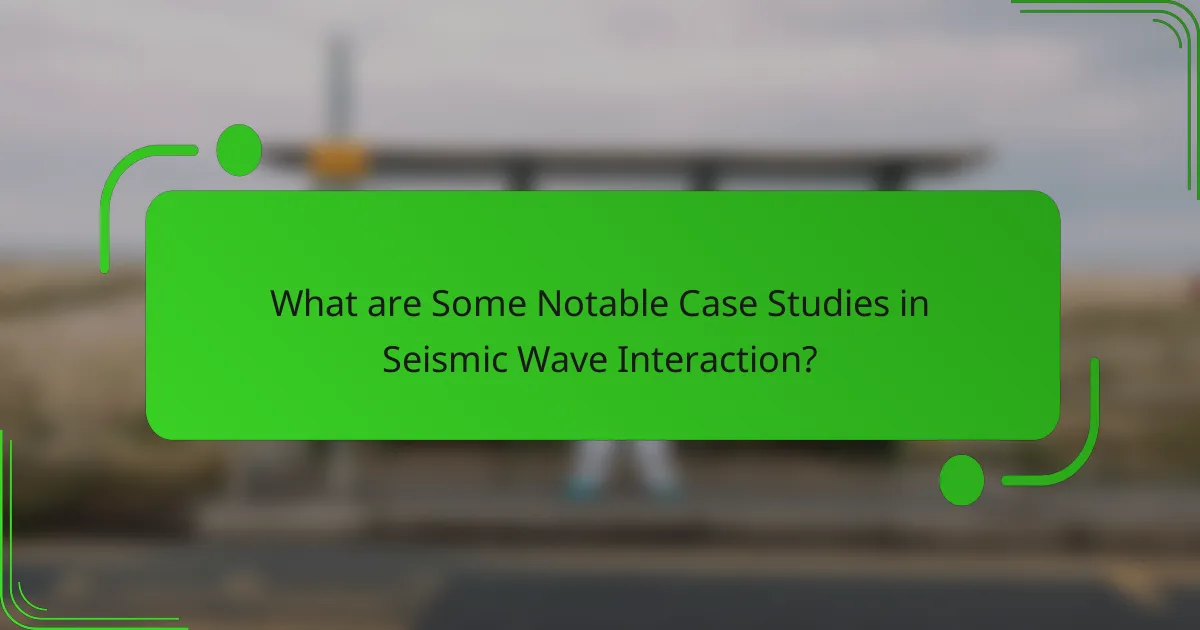
What are Some Notable Case Studies in Seismic Wave Interaction?
Notable case studies in seismic wave interaction include the 1994 Northridge earthquake, the 2011 Tōhoku earthquake, and the 2010 Haiti earthquake. In the Northridge earthquake, seismic waves interacted with complex geological layers, leading to significant ground shaking. This case revealed how local geology can amplify seismic waves, causing more damage than expected. The Tōhoku earthquake demonstrated the effects of seismic waves traveling through varying sediment types, which influenced tsunami generation. In Haiti, seismic wave interaction with poorly constructed buildings exacerbated the disaster’s impact. These case studies illustrate the critical role of geological conditions in seismic wave behavior and their implications for engineering and disaster preparedness.
What significant events have highlighted the interaction of seismic waves and geological layers?
The 1960 Valdivia earthquake in Chile significantly highlighted the interaction of seismic waves and geological layers. This earthquake, measuring 9.5 on the moment magnitude scale, is the most powerful recorded. It provided insights into how seismic waves travel through different geological formations. The event’s aftershocks revealed the complexities of wave propagation in layered earth materials. Additionally, the 2004 Sumatra earthquake demonstrated the impact of seismic waves on coastal geological structures. The resultant tsunami further illustrated the relationship between seismic activity and geological responses. These events have been pivotal in advancing seismology and understanding earthquake mechanics.
How did the 2011 Tōhoku earthquake illustrate these interactions?
The 2011 Tōhoku earthquake illustrated the interaction of seismic waves with geological layers by demonstrating how different strata affect wave propagation. The earthquake, with a magnitude of 9.0, generated powerful seismic waves that traveled through various geological formations. As these waves moved from the oceanic crust to the continental crust, their velocity and amplitude changed significantly.
This change occurred due to the differing densities and elastic properties of the geological layers encountered. For instance, seismic waves slowed down as they entered the softer sediments of the Tokyo Bay area. The earthquake’s impact was amplified in regions with thick sedimentary layers, causing more intense shaking.
The recorded data showed that areas with complex geological structures experienced unique wave patterns. This phenomenon provided valuable insights into how seismic waves interact with geological layers, contributing to better understanding and preparedness for future earthquakes.
What insights were gained from the 2004 Indian Ocean earthquake and tsunami?
The 2004 Indian Ocean earthquake and tsunami provided critical insights into tsunami warning systems. It highlighted the need for improved detection and communication technologies. The event demonstrated the importance of international cooperation in disaster response. Researchers learned about the geological factors influencing tsunami generation. The disaster underscored the vulnerability of coastal populations to such natural events. It also emphasized the significance of public education on tsunami preparedness. The earthquake’s magnitude, recorded at 9.1-9.3, was one of the largest ever measured. These insights have since influenced global tsunami research and policy development.
What lessons have been learned from these case studies?
Case studies on the interaction of seismic waves with geological layers reveal several key lessons. First, the importance of accurately characterizing geological layers is evident. Precise data on layer composition enhances seismic wave interpretation. Second, varying seismic wave velocities across different materials significantly affect wave propagation. This variability can lead to misinterpretations if not accounted for. Third, the use of advanced modeling techniques improves understanding of seismic responses. These models help predict how waves interact with complex geological structures. Lastly, collaboration between geologists and seismologists is crucial for comprehensive analysis. This interdisciplinary approach fosters better-informed decisions in seismic hazard assessments.
How have these events influenced seismic research and safety measures?
Significant seismic events have greatly influenced seismic research and safety measures. These events often lead to increased funding for research initiatives. For instance, the 2011 Tōhoku earthquake prompted advancements in early warning systems. Researchers focused on understanding wave propagation through various geological layers. This understanding has improved building codes and construction practices in earthquake-prone areas. Moreover, seismic events have driven the development of real-time monitoring technologies. Enhanced data collection methods have resulted from the analysis of past earthquakes. These improvements directly contribute to better preparedness and response strategies.
What best practices can be derived from analyzing these case studies?
Best practices from analyzing case studies in seismic wave interactions include thorough data collection and analysis. Accurate measurements of seismic wave properties are essential. Employing advanced modeling techniques enhances understanding of wave behavior. Collaboration among geologists, seismologists, and engineers improves interpretative accuracy. Regular updates to methodologies based on new findings ensure relevance. Utilizing technology such as machine learning can optimize data interpretation. Case studies demonstrate the importance of site-specific assessments for effective application. Continuous training for professionals in the field enhances skill sets and knowledge.
What practical tips can enhance understanding of seismic wave interactions?
To enhance understanding of seismic wave interactions, utilize visual simulations of wave propagation. These simulations illustrate how waves travel through various geological layers. Engage in hands-on experiments using wave tanks to observe physical wave behavior. Analyze data from real seismic events to connect theory with practical examples. Study the properties of different geological materials, as they affect wave speed and attenuation. Collaborate with experts in geophysics for deeper insights. Participate in workshops or courses focused on seismic analysis techniques. Reviewing case studies of past seismic events can provide valuable context and understanding.
The main entity of the article is the interaction of seismic waves with geological layers. This article provides a comprehensive overview of seismic waves, including their types, propagation methods, and the geological layers they interact with, such as the crust, mantle, and core. It discusses the implications of these interactions for earthquake prediction, construction practices, and resource exploration, as well as the methodologies used to study seismic wave behavior. Additionally, notable case studies highlight the significance of understanding these interactions in real-world scenarios, emphasizing their impact on seismic research and safety measures.
